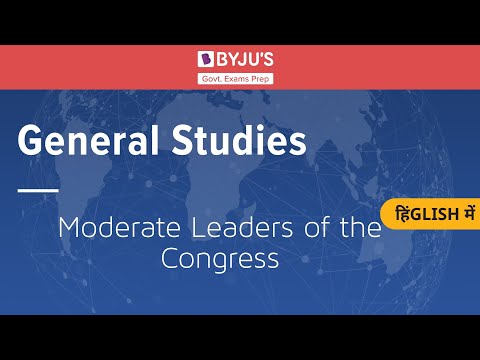An understanding of the differences between the moderates and the extremists of the Indian National Congress is important for a Civil Services aspirant as questions are repeatedly asked on this topic in the UPSC Prelims and Mains examinations. To know more about the UPSC Syllabus in detail visit the linked article.
Moderates, Extremists, Passive and Active Resistance – UPSC Notes:- Download PDF Here
| Aspirants can kickstart their UPSC 2022 preparation now!!
To complement your preparation for the upcoming exam, check the following links: |
Origin of the Moderates and Extremists of INC
The 1907 Indian National Congress (INC) session at Surat saw the formation of two factions with different ideologies and objectives. The period between 1885 – 1905 is knowns as the era of the moderates. The fact that the moderates were not able to achieve any notable goals was a bone of contention for many members of the INC. The partition of Bengal in 1905 was the catalyst that led to the rise of extremist in the INC.
Difference between Moderates and Extremists
We can differentiate between Moderates and Extremists on the basis of the below factors as outlined in the table.
Difference Between the Moderates and Extremist Factions of the INC
| Factors | Moderates | Extremists |
| Ideology | 1. They believed in the efficacy of peaceful agitation.
2. They believed in the British sense of justice and fair play. 3. They were inspired by the ideas of western philosophers like Mill, Burke, Spencer and Bentham. Moderates imbibed western ideas of liberalism, democracy, equity and freedom. |
1. They were radical in their approach. Demands of extremists were aggressive.
2. They believed in self-reliance as a weapon against domination. 3. Ideological inspiration was Indian history, cultural heritage, national education and Hindu traditional symbols. Hence, they revived the Ganapati and Shivaji festivals to arouse the masses. 4. They wanted to inculcate pride in India’s glorious culture to generate the spirit of nationalism. They invoked goddesses Kali or Durga for strength to fight for the motherland. 5. Guided by four principles: Swarajya, Swadeshi, Boycott of foreign goods and National education to make Indians self-aware of their national identity |
| Contributions | 1. Economic Critique of British Imperialism
2. Constitutional Reforms and Propaganda in Legislature 3. Campaign for General Administrative Reforms 4. Defence of Civil Rights |
1. Demand of Swaraj
2. Contributing to the rise of mass movements 3. The spread of nationalist education 4. Upliftment of the downtrodden 5. Support for revolutionary movements 6. Rise of communalism 7. Encouraged co-operative organisations 8. Installed charitable association for rural sanitations, preventive police duties, and regulated fairs and pilgrims gatherings to provide relief funds during famines and other calamities |
| Mass Base | It was highly elitist. They belonged to an urban background, and most of the people lived in England. Most of the moderate leaders admired British political institutions. They were not against the British rule in India, but they were against the ‘Un-British’ character of the British rule in India. | It was mainly urban-middle class. They believed in an India for ‘Indians’. They wanted to project the ‘cultural nationalism’ of India. |
| Methods | Prayer, Petition, Persuasion and Philanthropy. Their demands were constitutional, and so was their agitation. Their methods were regarded as ‘Passive Resistance’. Their style of working revolved around boycott. | Extremists were radical in terms of their approach, and believed in militant methods including but not limited to the assassination of key personnel. |
| Objectives | Their objectives were related to self-government. | The extremist demanded Swaraj or complete independence from British rule |
| Technique | The Moderates believed that political connections with Britain were in India’s interest during that time and that the time wasn’t ripe for a direct challenge to British rule. | The extremists believed in self-reliance as a weapon against domination. They promoted Swadeshi and boycott of foreign goods. |
| Faction Leaders | Dadabai Naoroji, Gopal Krishna Gokhale, A.O. Hume | Bal Gangadhar Tilak, Bipin Chandra Pal, Lala Lajpat Rai, and Aurobindo Ghosh |

Passive and Active Resistance of the Factions
- The theory of ‘Passive Resistance’ was presented by Aurobindo Ghosh, who is known as the Father of Indian Extremism. Aurobindo Ghosh wrote two books, i.e. ‘New Lamps for Old’, and the other being, ‘Savitri’.
- In ‘New Lamps for Old’, Aurobindo explained the doctrine of ‘Passive Resistance’, i.e. doing something so that the Government could be held in check. In Savitri, he referred to India as ‘Bharat Mata’.
- Therefore, the emotional fervour of Aurobindo Ghosh was reflected in these two books. Barindra Ghosh, who was Aurobindo’s brother was a Revolutionary Nationalist and believed in ‘active resistance’. Barindra Ghosh raided an arms depot at Alipore and was subsequently arrested along with Aurobindo Ghosh. This was known as the ‘Alipore Conspiracy’ case, 1902. Thus both Aurobindo Ghosh and Barindra Ghosh were in jail.
- The famous lawyer, R. Das brilliantly defended Aurobindo Ghosh in the ‘Alipore Conspiracy’ case. Aurobindo was acquitted citing lack of evidence, but Barindra Ghosh was given imprisonment for life. After acquittal from the case, Aurobindo took retirement from active politics and settled in Pondicherry. Thus Aurobindo gave a new direction to extremism by adding a religious as well as an emotional fervour to it.
Also read other important Modern History articles:
Related Links:
| India’s Independence Struggle | Home Rule Movement | Swadeshi Movement |
| UPSC Calendar 2022 | Battle of Colachel | Champaran Satyagraha |
| Government Exam | Government Schemes | IAS Eligibility |



Comments